Ep. 12: Make Sense of Your FBA Data
![How to make sense of your FBA data like a pro [background picture of data sheets]](https://autismclassroomresources.com/wp-content/uploads/2019/10/My-Post-2019-10-30T194409.792.jpg)
EXAMPLE OF WHAT FBA DATA TELLS US
So let’s say you look at your FBA data. Your antecedent is that the cookies just came out of the oven and everybody is waiting in line to get a cookie. Sarah screams; that’s her behavior. And she screams. Then, as she’s screaming, she gets to the front of the line and she’s given a cookie. So that’s our very common ABC data kind of strategy for wanting something that isn’t immediately available, which is a function of for many of our students. But when you look at your data and see is that some days when you’re baking cookies, this happens and other days Sarah waits quietly in line.
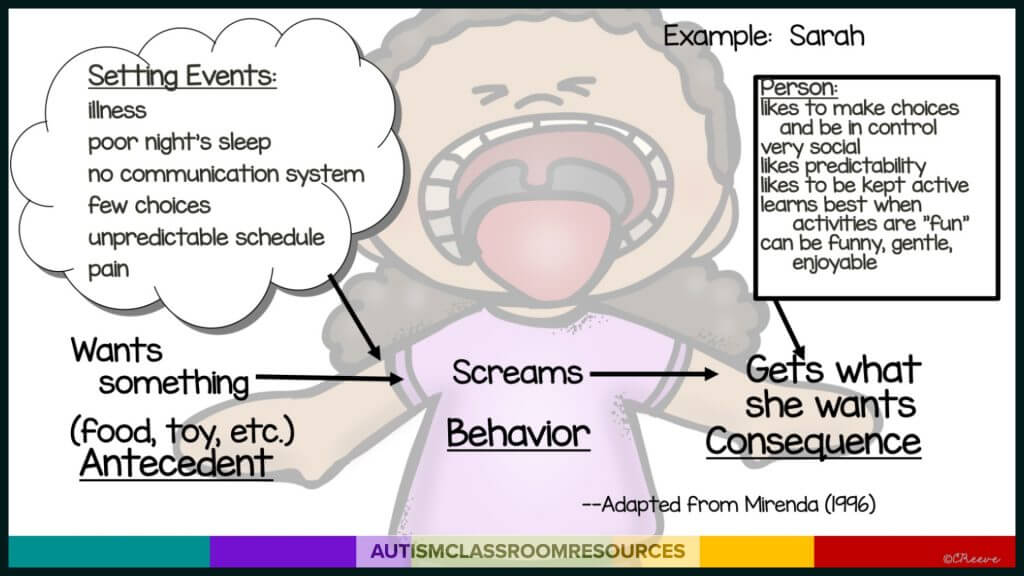
LOOKING AT THE WHOLE STUDENT
One of the reasons that you might be seeing that difference, as we talked about in Episode 11, is because of setting events. So let’s say that Sarah didn’t sleep well last night. Well maybe that’s something that makes it more likely that smelling and seeing the cookies causes her or leads to screaming instead of waiting.
Or maybe it’s that everything has been somewhat unpredictable today and so the schedule has been off; things have been happening that don’t normally happen. Maybe that was a setting event.
IMPACT ON INCONSISTENT FBA DATA
So something is affecting why sometimes she does this and sometimes she doesn’t. So that’s a cue to me that I want to go back through my interviews, what I know about Sarah, my conversations with her family to find out if there are days that she hasn’t slept well or she might not feel well or she doesn’t have a communication system available that day or her schedule was unpredictable.
If those things play a role, I want to make sure I factor that into my FBA data analysis. I also want to make sure that I factor in who Sarah is as a person because that’s going to play a role when we get to putting the hypotheses together. Sarah is a person who likes to make choices. She likes to be in control, she’s social, she likes predictability, she learns best when things are fun and engaging and she can be just a really cool kid. So I think those are important things that we need to keep in mind because those are going to play into how we design her behavior support plan.
GRAPH YOUR FBA DATA
Our next step then is to figure out what Sarah’s data is telling us and one of the best ways to do that is to graph the data. We have research that shows that teachers who graph their instructional data have students who make more progress. It’s reasonable to assume that graphing and summarizing our ABC data is also going to have that same impact. It’s going to allow us to investigate different avenues that might be affecting the behavior.
Your ABC data should prevent guessing in your behavior support plan. Graphing and analyzing it effectively is key. Without analysis, why take the data? #dontwasteyourtime #pbis #behaviormanagement
Click to Tweet
In an earlier post, I talked about using index cards to record the ABC data. If you’re using that, you can stack up your index cards according to the different antecedents, the different consequences, and you don’t necessarily need to graph them, but you will need to have a summary of them of some sort.
GRAPH FBA DATA BY ANTECEDENTS
The first question is whether there are common antecedents? So review your data and figure out if there are groups of things that you can classify together as common antecedents. Are they often engaging in behavior following the teacher working with another student? Are they often engaging in problem behavior in the hallway or while they’re waiting for their turn in a group activity or during a transition between different activities? These are events that give you an idea about what most commonly precedes the behavior, and that may allow you to figure out what is actually triggering the behavior most of the time.
WHAT THE FBA DATA TELLS US WITH ANTECEDENTS
In addition, this graph gives you information about what antecedents we might need to change, or at least temporarily change, to maybe prevent the challenging behaviors from happening in the first place. So one of the first things we talk about when we’ll talk about behavior support will be the antecedent strategies. Your antecedents from your data are going to inform what that means. And really that’s the most important part, because if our data isn’t feeding our behavior plan, it’s not really doing us much good. And that’s really the focus of what we need to talk about.
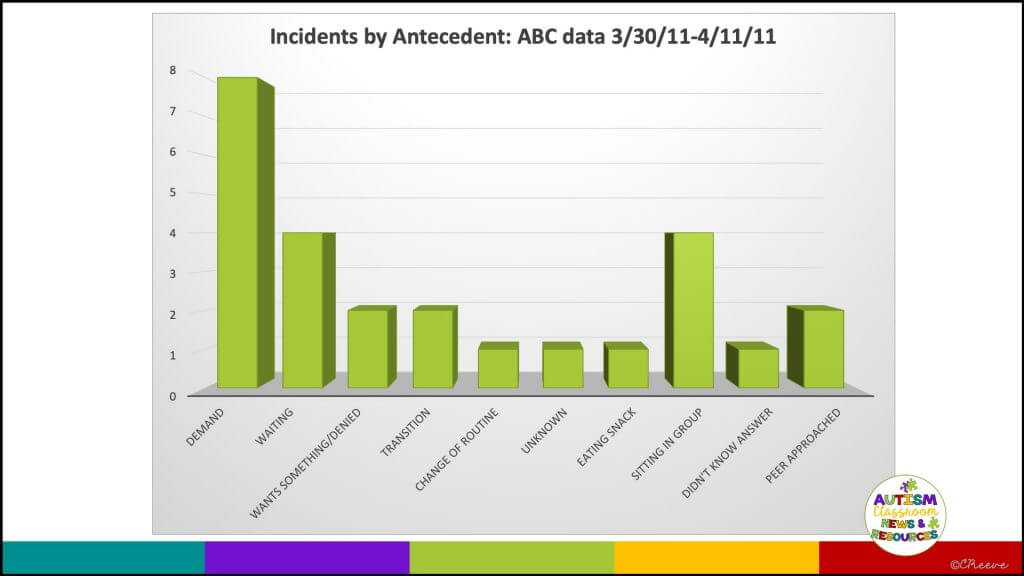
So I might be looking at things like a bar graph that looks at transitions, work demands being left alone, asking for something but being refused changing of the routine eating snack sitting in a group didn’t know the answer to a question was approached by a peer, was asked to do work.
COMMON CONSEQUENCES?
So another thing that you want to know from your FBA data is are there common consequences? So that’s going to give us information possibly about what might be reinforcing their behavior or maintaining the behavior. What keeps it going over time? The consequences, what keeps it on track keeps it going or makes it worse.
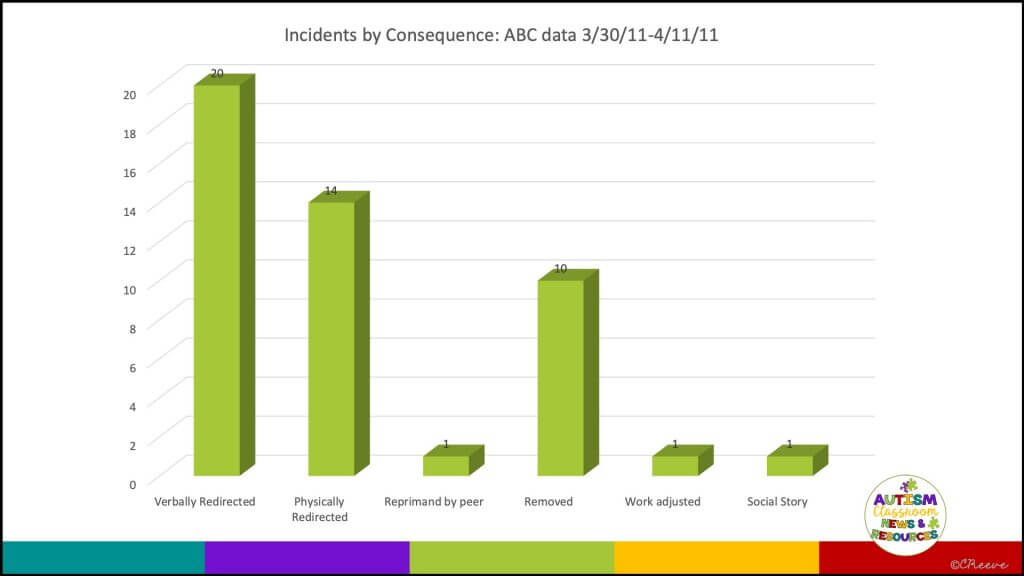
So some common consequences that you might look at would be that he was redirected, or reprimanded, or left to work on his own. The peers reacted in some way. An adult talked to other students, verbally redirected, removed from the situation. His work was adjusted. He didn’t get his work done. Somebody presented a social story to him. All those are things that might happen in response to the behavior or as the behavior is going on that might reinforce the challenging behavior.
LOOK FOR COMMON SETTINGS IN FBA DATA
So it might also be helpful to pinpoint which classes or settings have more frequent problems. Sometimes it’s helpful to graph the ABC data by the setting the student is in. That may give you information that there’s something specific to that setting or that class, maybe that work is too easy or maybe that work is too hard. Maybe it’s a group, large group activity and he has a hard time waiting for turns. Whatever it is, it gives us a place to look for more information. It may give us information about the variables that affect the behavior. It also gives us very important information about where our interventions in our behavior support plan are going to be most needed. So that’s going to be a key element.
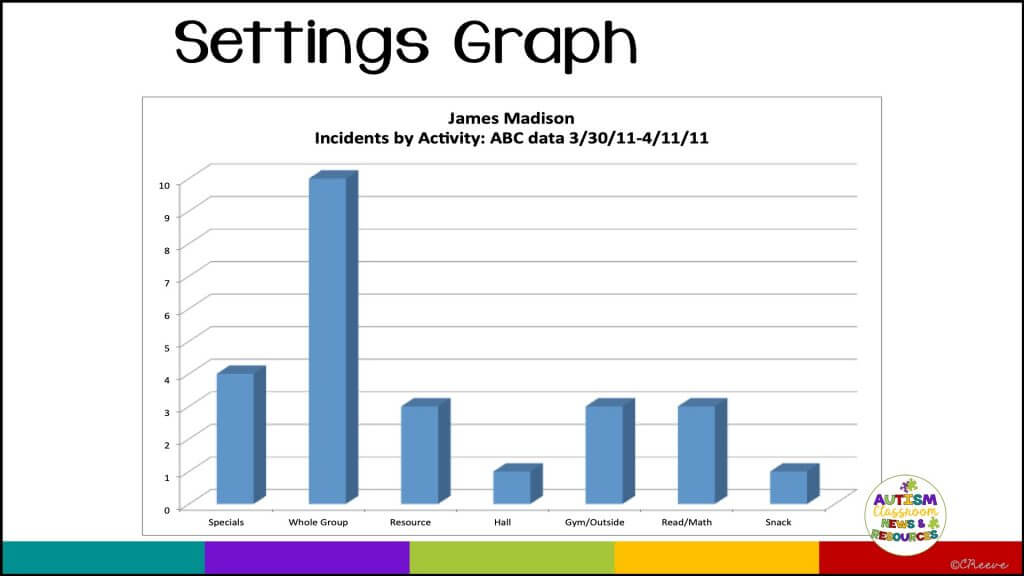
We might look at it by specific activities, so morning meeting, PE, lunch, a snack time, math time, reading class, music class. Or we might look at it by whole group versus resource room versus the hall versus academic time. So it’s gonna make a difference of what you know about the student in terms of how you want to break those settings down that you think is playing a role.
SPECIALIZED SITUATIONS FROM ABC DATA
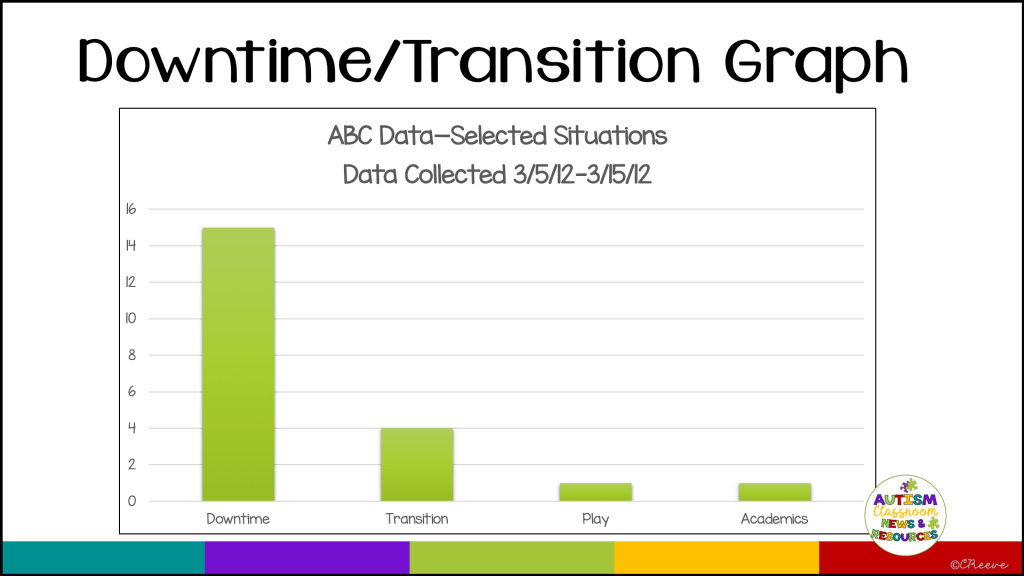
Another option in this is to how sometimes it’s helpful to consider common situations like downtime or transitions that might play a factor. So be specific in looking at that. Now obviously most of us in our classroom don’t have an activity called downtime; but if you think about it, waiting for the bathroom, waiting in the lunch line, waiting to leave the classroom, waiting for their turn in a group activity. Those are all times that our students are not necessarily actively engaged and, because of that, it basically serves as downtime for them. And I’ve said many times that downtime’s not your friend in a classroom. So downtime may be something you specifically want to kind of pick out of the data as well.
CLASSIFY INCIDENTS BY FUNCTION
Another way that you can graph the data is to look at individual incidents and see if you can associate them with one of the hypotheses of the functions. We talked in an earlier episode about the functions of behavior. Can you graph the data of the number of incidents that you think serve that function– to be removed from a situation, to gain attention from other people? This works well if an individual’s incidents are clearly related to one function. If you can’t do this, then the other kinds of variables that you’re looking at are going to be even more important. If you can do this, it becomes a little bit easier. So in straightforward cases, this works well. I often find that when I’m doing this, I have to use the other ones because if I knew what the function was, I wouldn’t have needed the data.
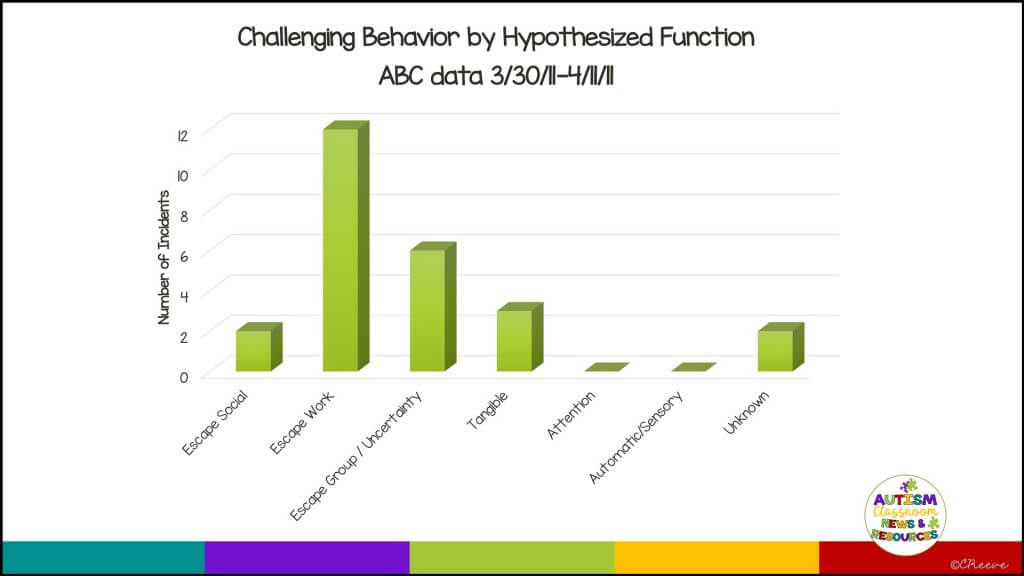
So keep that in mind. That may not always be as easy as it sounds, but we might end up with a graph that looks like escape, tangible items, attention, an automatic reinforcement. And I almost always on all of these have a column that’s called unknown called. I don’t have a clue, a, so consider that too, that sometimes there’s going to be data incidents that you look at and you’re, God, I don’t know what that was. And it’s okay to have an unknown column. Don’t put stuff in a column in unless you’re sure that’s where it belongs.
LOOK AT SETTING EVENTS
Next up, you really want to look at your setting events in your FBA data. So just like we talked about in Episode 11, are there setting events that we need to look at? So do we need to evaluate whether sleep patterns or illness or allergies co-occur with that behavior? And if so graph those on the same graph, look at them and see if they co-occur.
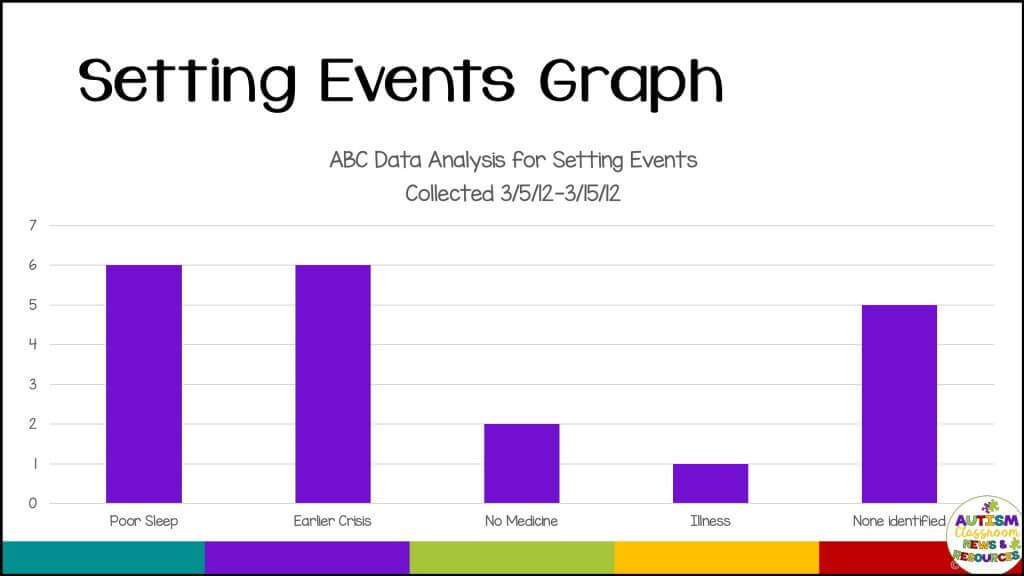
Do you need to evaluate whether another individual’s behavior in your class co occurs with your clients? I had a student that we really felt like the high noise level that was associated with increased challenging behavior of one student was actually exacerbating the challenging behavior of another student. Interestingly, although we thought that, when we graphed them on the same graph, we actually found they were not related, which then became part of our discussion as well. But I think that that’s really an important component to look at when you’ve got more than one challenge that you’re dealing with in your classroom.
And then you might make a graph that has setting events on it. So are there incidents that someone indicated they hadn’t slept well that night or hadn’t had their medicine or they didn’t feel well or things like that? Those are the kinds of things that might go into that bar graph. Now once we have our data summarized, then you can review it, review your interviews and other information to develop an overall picture of the situations that are related to the behavior you want to focus on. All of the information and how it fits together and the following are going to be some that we can use for kind of bringing that data together into a meaningful hypothesis. And it’s really important that we remember when we develop hypothesis statements that we want to make sure that they’re complete single word descriptions of the function of behavior are rarely helpful in developing our behavior support plan.
SUMMARY

And because of that, just saying it’s escape related doesn’t tell us what to do about it. What is he escaping and what kinds of situations? When is it most likely to happen? So for that we need more complete hypothesis statements and the more information that you have to work from, the better your behavior plan is going to be.
So join us next time when we’ll be talking about how we write those behavioral hypothesis statements based on the data that you’ve analyzed from today’s episode.
I hope that you’re enjoying the podcast and I’d love it if you’d hop over to iTunes and leave a review or and or subscribe a so that you will continue to get episodes.




